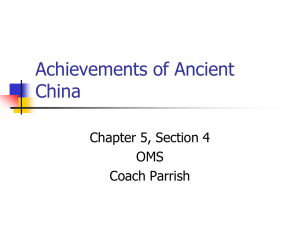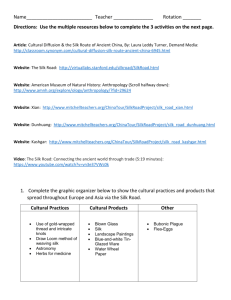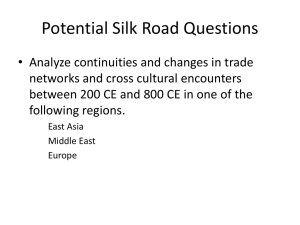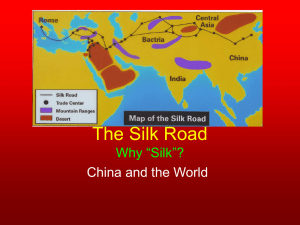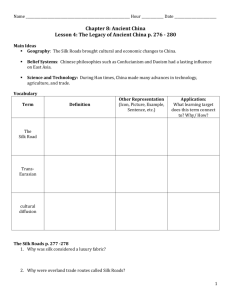Silk Road Reading Unit - 4th
advertisement
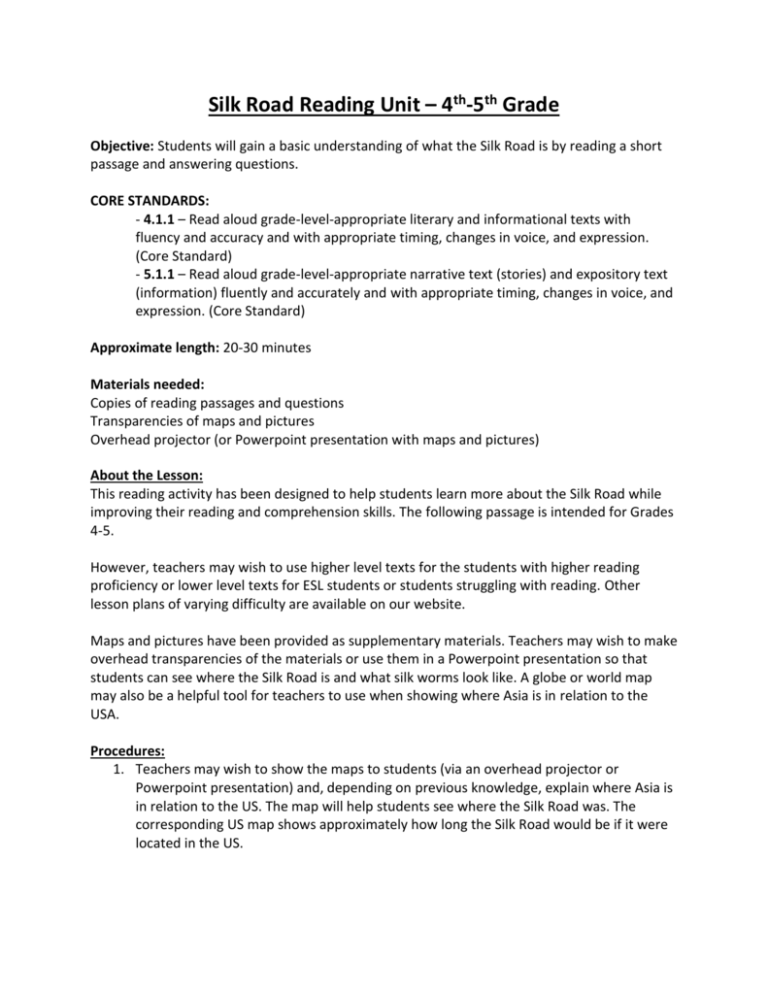
Silk Road Reading Unit – 4th-5th Grade Objective: Students will gain a basic understanding of what the Silk Road is by reading a short passage and answering questions. CORE STANDARDS: - 4.1.1 – Read aloud grade-level-appropriate literary and informational texts with fluency and accuracy and with appropriate timing, changes in voice, and expression. (Core Standard) - 5.1.1 – Read aloud grade-level-appropriate narrative text (stories) and expository text (information) fluently and accurately and with appropriate timing, changes in voice, and expression. (Core Standard) Approximate length: 20-30 minutes Materials needed: Copies of reading passages and questions Transparencies of maps and pictures Overhead projector (or Powerpoint presentation with maps and pictures) About the Lesson: This reading activity has been designed to help students learn more about the Silk Road while improving their reading and comprehension skills. The following passage is intended for Grades 4-5. However, teachers may wish to use higher level texts for the students with higher reading proficiency or lower level texts for ESL students or students struggling with reading. Other lesson plans of varying difficulty are available on our website. Maps and pictures have been provided as supplementary materials. Teachers may wish to make overhead transparencies of the materials or use them in a Powerpoint presentation so that students can see where the Silk Road is and what silk worms look like. A globe or world map may also be a helpful tool for teachers to use when showing where Asia is in relation to the USA. Procedures: 1. Teachers may wish to show the maps to students (via an overhead projector or Powerpoint presentation) and, depending on previous knowledge, explain where Asia is in relation to the US. The map will help students see where the Silk Road was. The corresponding US map shows approximately how long the Silk Road would be if it were located in the US. 2. Teachers should place pictures of the silk worms and their cocoons on the overhead projector. Leave them up while the students are working. Don’t explain yet to the students what the pictures are. Tell them they will find out as they read the passage. 3. Teachers should hand out the reading passage and accompanying question and answer worksheet. Have students read the passage and answer the questions. 4. Ask students if any of them know what the pictures are now. You may wish to discuss the passage further with students or ask them what experience they have had with silk. Name:___________________________________ Introduction to the Silk Road – 4-5th Grade Definition The “Silk Road” is the name given to a group of trade routes between the Mediterranean Sea and East Asia. A route is like a path or road. The Silk Road had both land and sea routes. It covered more than 4,600 miles. (That’s like driving from Disneyworld in Orlando, FL to the Iditarod Dog Sled Race in Anchorage, AK! That would take over three and a half days to drive. Can you imagine how long it would take to walk?) The Silk Road was used from around 200 BCE to 1500 CE. However, it was named the ‘Silk Road’ not very long ago. A German scholar, Ferdinand von Richthofen, gave the trade routes that name in 1877. He created the term based on Rome’s historical connection to the trade route and their love of silk.1 Story Behind the Name Scholars say that the Romans first saw silk after defeating some enemies in 53 BCE. They learned from prisoners that the silk came from the east. The Romans took samples of the silk back home and it became very popular in Rome for its soft texture and beauty. The Romans sent their own agents out to explore the route east and try to buy silk at a lower price than the one set by their neighbors. For this reason, the trade route to the East was used by the Romans mainly to buy silk, although they also bought other goods. Fun Facts The Romans did not know how silk was made. They thought the material for silk came from trees. However, silk is actually made from the cocoon of silk worms. Also, Romans liked silk so much the government had to put a ban on it in 14 BCE because it was ruining their economy. The ban didn’t work very well, though. People still bought silk anyway. 1 Tucker, Jonathan. The Silk Road: Art and History. Art Media Resources, 2003. p 15. Questions 1. What was the Silk Road? _________________________________________ _____________________________________________________________ 2. How long was the Silk Road? ______________________________________ _____________________________________________________________ 3. When did the Silk Road receive its name? ___________________________ _____________________________________________________________ 4. Which people really liked silk? ____________________________________ _____________________________________________________________ 5. What is silk made out of? ________________________________________ _____________________________________________________________ Bonus Questions!!! Silk was very expensive to buy and was hurting the Roman economy. What did the Roman government do to try to stop people from buying silk? ___________________________________________________________________ ___________________________________________________________________ Have you ever touched silk? How does it feel? ____________________________ Transparencies




